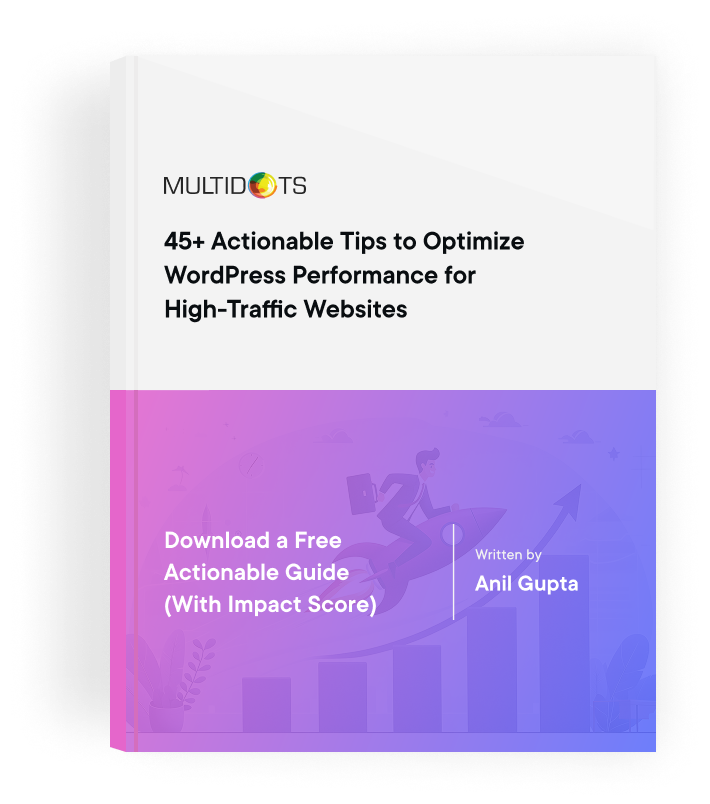Essential Guide: Moving Substack to WordPress Efficiently
Migrate your Substack content to WordPress effortlessly with expert guidance for growth, design, and audience retention.

Table of Contents
Imagine elevating your newsletter to a space where you control everything: the design, SEO, and the reach. Substack’s simplicity has its perks, but if you’re ready to move beyond its limits, WordPress offers so much more. Just look at The Website Flip, which saw an incredible 10x jump in new readership after making the switch. We want to help you do the same, minus the headaches.
We’ll cover each step in moving from Substack to WordPress, from exporting content to setting up a site ready to scale. With over 200 migrations completed (and even Google tapping us for Core Web Vitals expertise), Multidots knows how to make the entire journey smooth and future-proof. This guide is packed with tips, tricks, and insider insights so you can focus on what matters: your audience.
Why Migrate From Substack to WordPress?
Why migrate from Substack to WordPress
Switching from Substack to WordPress offers serious content creators many advantages. WordPress allows for advanced customization, so you can tailor every aspect of your site’s look and feel, creating a unique brand experience that’s truly yours. With the Gutenberg editor, you can easily design and structure content using a block-based approach, giving you flexibility and control without needing extensive coding knowledge. You’ll also gain full control over SEO settings, including metadata, URL structures, and SEO plugins – all of which open the door to greater visibility and organic reach.
But it doesn’t stop there. WordPress supports loads of monetization options, from display ads and sponsored content to full eCommerce integration, offering more ways to grow revenue. Plus, with integration into advanced marketing and analytics tools, WordPress provides deeper audience insights. As your traffic scales, WordPress’s infrastructure will keep up, letting your site grow without hitting performance snags.
Ultimately, WordPress’s open ecosystem future-proofs your content business, giving you the flexibility to adapt to new trends and content formats. It’s a platform built for creators who want long-term control, scalability, and a sustainable online presence.
Preparing for the Move From Substack to WordPress
Moving from Substack to WordPress requires careful planning to make sure nothing falls through the cracks. Start by developing a clear migration strategy and timeline. This plan will be your roadmap, helping you keep track of each step and avoid unnecessary delays. Next, you’ll want to audit your existing Substack content and subscriber data to understand what needs to be migrated (and don’t forget to identify any potential gaps in your current setup!)
Steps to migrate from Substack to WordPress
Choosing the right WordPress hosting provider is the trick here, particularly for stability and performance, so research options that can handle both your current needs and future growth. Along with this, choose a WordPress theme that aligns with your brand’s aesthetic and user experience goals to keep your newsletter’s look and feel consistent. Before exporting anything, remember to back up all your Substack data – it’s the best way to prevent any accidental losses along the way.
These steps will set the foundation for a smooth migration. But don’t worry; we’ll break down each stage in detail, from exporting content to optimizing your new WordPress site for success!
Exporting Your Substack Content and Subscribers
To start, log into Substack and go to Settings. Under the menu, you’ll find the Export option. Select the data you want (like posts, images, and your subscriber list) and initiate the export.
Exporting your Substack data is an essential first step in the migration process, as it means you won’t lose any of your valuable content or subscriber information. Depending on the amount of content, the export process might take some time. Once it’s complete, download the exported files, which are typically in CSV format for subscriber lists and ZIP for content.
Store these files securely on your local device or cloud storage, keeping everything organized for the next steps. Before moving forward, double-check that all posts, images, and subscriber information have been successfully exported – this will help you avoid any nasty surprises down the line.
Setting up Your WordPress Site
With your Substack data safely exported, it’s time to set up your new WordPress site. Start by choosing and registering a domain name if you don’t already have one. Next, find a reliable WordPress hosting provider with strong performance and support options – many offer one-click WordPress installation to simplify the process.
Once WordPress is installed, pick a theme that aligns with your newsletter’s style and customize it to fit your brand. This is a super fun stage, as you’ll have full control over this! You’ll also want to install essential plugins to support your newsletter, including email marketing integration tools for managing subscribers and sending updates.
Before you’re fully set, configure basic WordPress settings like timezone and permalink structure to ensure a solid foundation for your site’s functionality. This setup is all about creating a site that reflects your brand and taking a bit of time now means a smooth experience for you – and an even better experience for your followers!
As a bonus, think about how this migration could allow you to expand your content strategy. With WordPress’s flexibility, you can easily explore new content types beyond newsletters, opening up more opportunities for audience engagement and growth!
Step-by-Step Guide: Importing Substack Content to WordPress
Step 1: Set Up Your WordPress Site
Make sure your WordPress site is fully set up before importing your Substack content. This includes choosing a domain, installing WordPress, and customizing your theme and essential plugins to align with your brand.
Step 2: Export Content from Substack
Log into Substack and go to Settings. Under the menu, locate the Export option. Select the data you want to migrate, such as posts, images, and your subscriber list, then initiate the export. Once complete, download the exported files (typically in CSV format for subscribers and ZIP format for content) and store them securely.
Step 3: Choose an Import Method for WordPress
Use the Substack Importer plugin for WordPress to simplify the process of importing content. Note that this tool has limitations – premium content and podcasts may not transfer smoothly, so you’ll need to plan for these gaps. If you haven’t already exported your content, do that now!
Step 4: Handle Multimedia and Special Content Types
Content such as images and multimedia files may have specific export formats requiring additional attention during import. Upload these files manually to WordPress if needed and map them to the correct post types.
Step 5: Fix Formatting and Organize Content
Common migration issues include formatting discrepancies, broken embeds, and missing media elements. Review each imported post carefully and fix any issues to ensure a smooth reading experience. Adjust permalinks, categories, and tags in WordPress to improve content organization and accessibility for your audience.
Step 6: Replicate Substack Features
For paid subscriptions or newsletter-style content, leverage WordPress plugins like MemberPress or the Newsletter Plugin to replicate Substack’s features. These plugins can enhance your subscribers’ experience and ensure smooth functionality for premium content.
Step 7: Communicate Changes to Your Subscribers
Maintaining subscriber relationships during migration is essential. Send out a clear announcement about the transition, reassuring your audience they’ll continue to receive content uninterrupted. A "welcome to the new platform" email series can smooth the transition and increase engagement.
At Multidots, we have experience handling large-scale, complex migrations and can also help tackle unique challenges, meaning your content (and subscribers!) transition smoothly to WordPress.
Preserving Your Audience: Subscriber Migration and Email Marketing
You’ve worked hard to build your subscriber base, so losing any of them in the move isn’t an option. After exporting your subscriber list from Substack, double-check the data for any formatting issues that might mess things up on the new platform.
Next, pick an email service provider (ESP) that works well with WordPress – Campaign Monitor, Mailchimp, or ConvertKit are great options. These ESPs offer tools for segmentation, automation, and detailed analytics, making it easier to keep your audience engaged and happy.
Kick off the transition with a "welcome to the new platform" email series. It’s a simple way to reassure your subscribers they’ll still get your content, plus any added perks from WordPress. And with WordPress plugins, you can take your email game further – think automated follow-ups, targeted messaging, and smarter segmentation!
Integrating your ESP with WordPress will boost deliverability and give you valuable insights into subscriber engagement. This way, you can keep your community strong and connected even as you grow.
Replicating Substack Features in WordPress: Subscriptions, Payments, and More
One of the best parts of moving to WordPress is that you can easily recreate – and even upgrade – many of Substack’s features. With the right plugins, WordPress can handle everything from free and paid subscriptions to payment processing and premium content paywalls. This means you can set up a fully customized subscription system, whether you want to offer exclusive content or paid tiers for loyal fans.
Integrating payment gateways like Stripe or PayPal lets you manage subscriptions effortlessly. And with plugins for newsletters and email automation, you can keep subscribers in the loop with notifications for every new post. From replicating the familiar Substack reading experience to implementing new engagement tools, WordPress offers endless options.
Multidots specializes in WordPress migrations and can create custom solutions tailored to your specific needs. With a strong background in optimizing editorial workflows and page speed performance, we make sure your newsletter platform is both efficient and fast (two essentials for keeping readers engaged!).
While there’s a bit of setup involved, the result is a powerful, flexible newsletter system that’s designed for growth. Plus, if any challenges come up during the migration, Multidots can help smooth out the process so you can build a platform that’s more adaptable than Substack could ever be.
Post-Migration Optimization: Boosting SEO, Performance, and Engagement
Post-migration optimization checklist
Once your content is on WordPress, it’s time to optimize. Start with an SEO audit to make sure your site is ready to perform well on search engines. Common issues post-migration include missing metadata and broken links, which can be tackled with SEO tools like Yoast or Rank Math. These plugins let you easily adjust metadata, improve readability, and keep your content search-friendly.
Setting up 301 redirects from your old Substack URLs to the new WordPress ones is necessary for preserving SEO value and ensuring your readers land on the right pages. Site speed is another big factor; use tools like Google PageSpeed Insights to spot any slowdowns. Multidots has a proven track record in page speed optimization and works with Google on Core Web Vitals, so we know how to get WordPress sites running fast.
Mobile optimization is also essential, as Google prioritizes mobile-friendly sites, so your WordPress setup should work on any device. To boost engagement, think about plugins that add features like related posts, commenting systems, and social sharing, all of which help build a more interactive experience.
With WordPress’s extensive plugin ecosystem, you also have room to expand with advanced features like membership systems or eCommerce. This opens up new ways to monetize that just weren’t possible on Substack, giving you full control over the growth of your content business!
Streamline Your Move with Multidots: Ensuring an Efficient Substack to WordPress Transition
Switching from Substack to WordPress is a chance to supercharge your brand and reach. With Multidots, you can make this leap without the usual stresses. We’re pros at WordPress migrations, handling everything from moving your content and subscribers to making sure your SEO stays intact.
Imagine a site that loads fast, works on every device, and lets you customize every detail. That’s what WordPress can do, and Multidots knows exactly how to get you there. We focus on things that matter – like Core Web Vitals and performance – so your audience has a smooth, standout experience.
Whether you’re an influencer or a startup ready to grow, this move opens doors. With more customization, better SEO, and new ways to connect with your followers, the potential is limitless. Let us handle the boring stuff so you can focus on building your brand and engaging your audience.
Curious about what WordPress can do for your newsletter? Contact us, and let’s talk about what’s possible.
Feel free to schedule a quick call with our migration expert.
Contact Us
